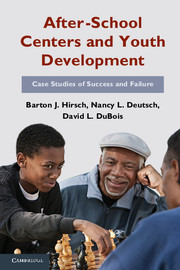Book contents
- Frontmatter
- Contents
- Figure and Tables
- Preface
- Introduction
- Midwest Center
- North River Center
- 6 A Study of Organizational Dysfunction
- 7 Undercutting Tweetie: The Trials and Tribulations of a Youth Leader
- 8 Beyonce: A Good Friend Is Hard to Find (and Keep)
- 9 Putting It All Together: North River and Midwest Centers
- West River Center
- Conclusion
- Appendix Data Sources
- References
- Index
6 - A Study of Organizational Dysfunction
Published online by Cambridge University Press: 05 June 2012
- Frontmatter
- Contents
- Figure and Tables
- Preface
- Introduction
- Midwest Center
- North River Center
- 6 A Study of Organizational Dysfunction
- 7 Undercutting Tweetie: The Trials and Tribulations of a Youth Leader
- 8 Beyonce: A Good Friend Is Hard to Find (and Keep)
- 9 Putting It All Together: North River and Midwest Centers
- West River Center
- Conclusion
- Appendix Data Sources
- References
- Index
Summary
The North River after-school center is a large structure that sits in the middle of a wide street dotted with dilapidated buildings and a smattering of newly renovated homes. Club staff monitor the entrance, ensuring that only club members, parents, and approved visitors enter. The neighborhood around North River is not very safe. The streets feel deserted, and there are few businesses within walking distance. Staff members often warn visitors not to walk in the neighborhood alone; their final words are always some version of “be safe out there.”
Our initial survey questionnaire provides a good indication of the youth (age ten and older) who come to the club. The survey was completed by 112 youth ages 10–17, with an average age of 12.8. The sample was 97 percent African American. Only two youth indicated other races (White, Hispanic). Sixty-three percent of the youth who completed the survey were male. It was a high-poverty sample, as 89 percent reported receiving free or reduced-price lunch. On average, youth reported coming to the center three days per week, and 25 percent reported that it was their first year at the center.
- Type
- Chapter
- Information
- After-School Centers and Youth DevelopmentCase Studies of Success and Failure, pp. 129 - 154Publisher: Cambridge University PressPrint publication year: 2011

